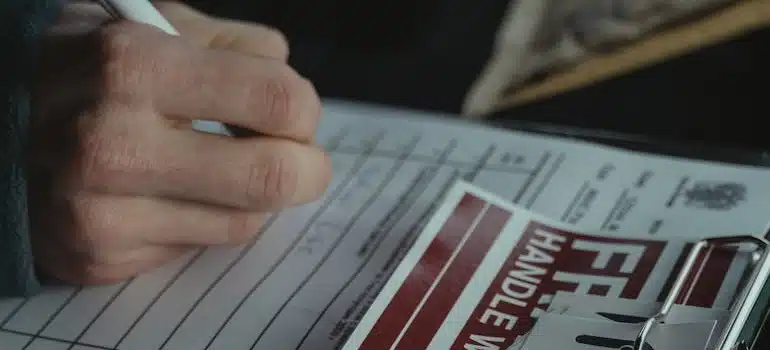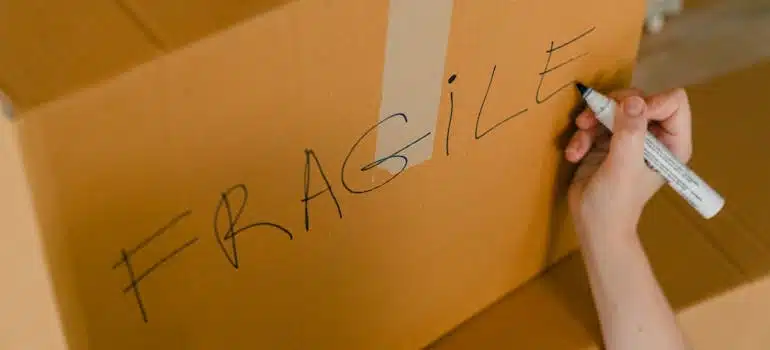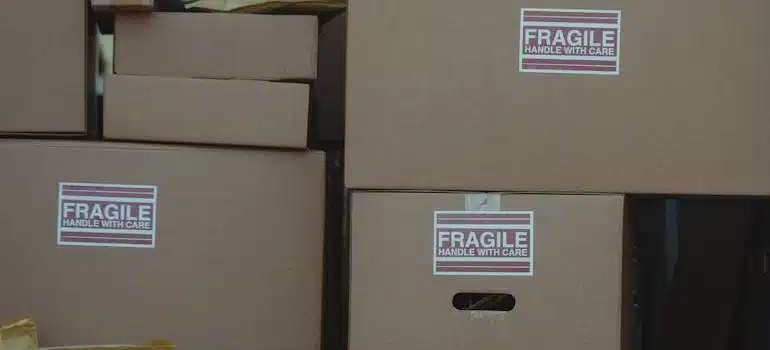How to efficiently pack fragile items like a pro
Packing fragile items takes more than wrapping things in paper and hoping for the best. Your breakables require extra care, whether it’s a vintage vase, a houseplant, or an expensive monitor. And the key is simple: combine professional-grade supplies with methodical packing techniques. This guide by our Miami movers walks you through both, covering ways to efficiently pack fragile items and explaining how to choose the best moving supplies and boxes for them.
Why the right supplies and techniques matter
Fragile items need extra protection, not just because they’re delicate but also because they’re often expensive or irreplaceable. Relying on general-purpose boxes and improvised wrapping may work for clothes or books, but it won’t hold up under pressure for glass, ceramics, or electronics.
Professional-grade supplies protect breakables in three key ways: they cushion impact, restrict movement inside the box, and reinforce structure so the item can withstand stacking and shifting during the move. Without these layers of defense, one tight turn in the moving truck or a heavy box stacked on top could lead to permanent damage.

Essential supplies and box types for packing fragile items
When it comes to packing breakable belongings, materials matter just as much as how you pack. To efficiently pack fragile items, you need the right combination of wrapping, cushioning, and containers. Here’s a breakdown of the most reliable packing supplies for fragile items, plus which boxes work best for each type:
Core supplies
- Bubble wrap: Wraps and cushions glass, electronics, ceramics
- Packing paper: Clean, ink-free paper for layering and wrapping
- Foam sheets or rolls: Add layers between plates, screens, and edges
- Packing peanuts: Fill gaps in boxes to prevent shifting
- Stretch wrap: Holds parts together (e.g., cords, lamp bases)
- Heavy-duty tape: Reinforced for sealing full or double-walled boxes
- Labels and stickers: Use “FRAGILE” labels and room/location tags
Specialty boxes
- Dish barrels: Thicker-walled boxes made for stacking plates vertically
- Mirror and artwork boxes: Adjustable cartons that hold framed items
- Electronics boxes: Often lined or padded; fit screens, towers, and speakers
- Lamp boxes: Tall, narrow, designed for lamps and other floor pieces
- Double-walled boxes: Ideal for heavy or high-value breakables
- Custom crates: Used for fine art, collectibles, or antique furniture
Labeling also plays a role. Use bright “FRAGILE” stickers, write the contents on the box, and mark the top to guide your white glove moving and storage pros. Stretch wrap can secure grouped items, cords, or oddly shaped parts like lamp arms or fan blades.
Why strength matters when sealing fragile boxes
Strapping tape vs. masking tape is an important comparison to make. Strapping tape is reinforced, heavy-duty, and designed for sealing full or heavy boxes. It resists tearing and holds strong even under weight.
Masking tape, by contrast, is meant for light applications and can peel or fail under pressure. For fragile items, strapping tape is the safer, more secure choice.
How to efficiently pack fragile items by category
Each fragile item type requires a slightly different packing method. The materials may overlap, but the order of wrapping, layering, and boxing changes depending on weight, shape, and surface sensitivity. Use the right method for each item; don’t let one-size-fits-all packing lead to damage.
Glassware, china, and pottery
Glassware and china break easily if packed without proper support. Each piece should be wrapped individually with clean packing paper. Plates need to be placed vertically, not stacked flat, inside a dish barrel box. Add a layer of foam or paper between each plate to reduce impact.
Stemware and cups should go into boxes with dividers or cell inserts. Protect stems and handles with extra padding and fill empty spaces with crumpled paper to prevent shifting. Mark each box as “FRAGILE” and load it where it won’t bear weight from other items. So whenever you need to pack your glassware, choose materials and methods that match its shape and fragility, as guesswork leads to broken pieces.
Pottery tends to be heavy with uneven shapes. Wrap each piece in bubble wrap and fill any hollow parts with paper. Place the heavier pieces at the bottom of the box and use foam to pad each layer. Avoid stacking different shapes together.

Electronics and small appliances
Electronics are especially sensitive to shock, moisture, and static. Whenever possible, pack items like TVs, monitors, printers, and home audio equipment in their original boxes. These boxes are designed to match the shape and weight of the device and often include custom inserts for protection. If original packaging isn’t available, wrap each item in anti-static bubble wrap and pad the corners with foam or dense packing paper.
To pack home audio equipment properly, disconnect all cords, secure any loose parts, and wrap components like receivers and speakers with extra padding; paying close attention to knobs, inputs, and glass displays. Speakers should be packed upright, with reinforced bottom padding and cushioning on all sides to avoid pressure damage during the move.
Secure cords with stretch wrap or tape, label everything clearly, and remove batteries from remotes or portable units to prevent leakage. Mark boxes as “FRAGILE” and indicate which side should face up.
Artwork, mirrors, and frames
Artwork, mirrors, and framed items are among the most sensitive objects to move and regularly require assistance from experienced antique movers. These valuables are vulnerable to scratches, cracks, and pressure damage because even small shifts in the truck can cause harm if the item isn’t packed properly.
Start by wrapping each piece in acid-free paper to protect painted surfaces, especially when packing canvas or oil-based artwork. This layer helps prevent smudging, abrasion, or chemical damage during transport.
Next, add a layer of bubble wrap for cushioning, then secure the corners with protectors. For paintings, make sure the bubble wrap doesn’t press directly against the painted surface, which is why you use acid-free layer as a buffer. Slide the item into a picture or mirror box, making sure the fit is snug but not tight. Oversized or high-value artwork may need custom crating to guard against vibration or heavy pressure in transit.
When packing and moving paintings, pay close attention to surface protection and support as damage often happens from compression or bending, not just breakage. Store these boxes upright and label them clearly as fragile and top-load only.

Antiques and collectibles
Antiques, rare books, and decorative collectibles often carry both financial and emotional value. These items need more than standard packing—they need protection that matches their age, shape, and fragility. Always start by wrapping delicate surfaces in soft, acid-free tissue paper, then add a layer of bubble wrap or foam. This creates cushioning without putting pressure directly on the object.
For items with unusual shapes, like figurines or carved ornaments, it helps to build a custom insert from foam or cardboard to prevent movement inside the box. Place the wrapped item in a smaller box first, then set that box inside a larger one with extra padding around it. This double-boxing method will reduce shock from vibrations or sudden bumps during transport.
Modern collectibles like limited-edition figurines, boxed board games, or display models need similar care. Original packaging offers a good starting point if it’s in good condition, but still reinforce it with padding. When packing board games for storage, avoid stacking these boxes with heavier items, and keep them upright when possible.
Lamps, light fixtures, and houseplants
These items are often awkward to pack due to their shape, size, and sensitivity. Lamps and light fixtures typically have multiple parts that can shift or break during a move. So if you need to pack lamps and chandeliers, first detach glass covers, bulbs, and shades first, and wrap them separately in bubble wrap or soft packing paper.
Use a sturdy box with padding to keep them from moving. Lamp bases should be wrapped in bubble wrap, then placed upright in a tall box with cushioning on the bottom and sides. Secure cords with stretch film or masking tape to avoid tangling or damage.
Light fixtures with delicate arms or exposed wiring may require extra reinforcement, so use foam padding and avoid stacking anything on top of these boxes. Label them clearly so movers handle them with care.
Houseplants need a different approach. Most can handle short trips, but not rough handling or sealed containers. Use an open-top box to allow airflow and place crumpled paper around the pot to keep it steady.
Avoid watering right before the move to reduce weight and mess. If you want to efficiently pack fragile items like these, know that moving household plants doesn’t just require padding but positioning and airflow too. Plan so they arrive in good shape.

Choosing and loading boxes for fragile items
Choosing the right box implies finding quality supplies first and then selecting one that matches the weight, shape, and fragility of the item. For heavier items like ceramics or electronics, use smaller boxes to prevent overloading. Lightweight fragile items, such as lampshades or glass decorations, can go in larger boxes, but only if the space is filled with cushioning.
Never leave empty spaces inside a box. Movement during transit is what causes most damage. Use crumpled paper or packing peanuts to fill all gaps. For highly fragile items, double-boxing provides the extra layer needed to absorb impact.
During the truck loading phase, heavy boxes should go on the bottom and lighter ones on top. Boxes with fragile contents should not bear any weight. If possible, set aside a specific zone in the truck for all marked “FRAGILE” boxes, and secure them to prevent sliding.
Labeling and unpacking: Avoid mistakes during the final steps
Proper labeling makes a difference if you want to efficiently pack fragile items. Write “FRAGILE” on multiple sides of each box, note which side is up, and indicate the room it belongs to. For expensive or rare items, take photos of the item before wrapping and after packing. Keep a simple inventory list for reference while unpacking.
When you arrive at your new home, start by unpacking the boxes with the most fragile and essential items. Avoid waiting days to open these; boxed-up moisture, shifting temperatures, or tilted stacks could lead to damage if left too long. Careful labeling and unpacking help you avoid packing mistakes during these final steps.
